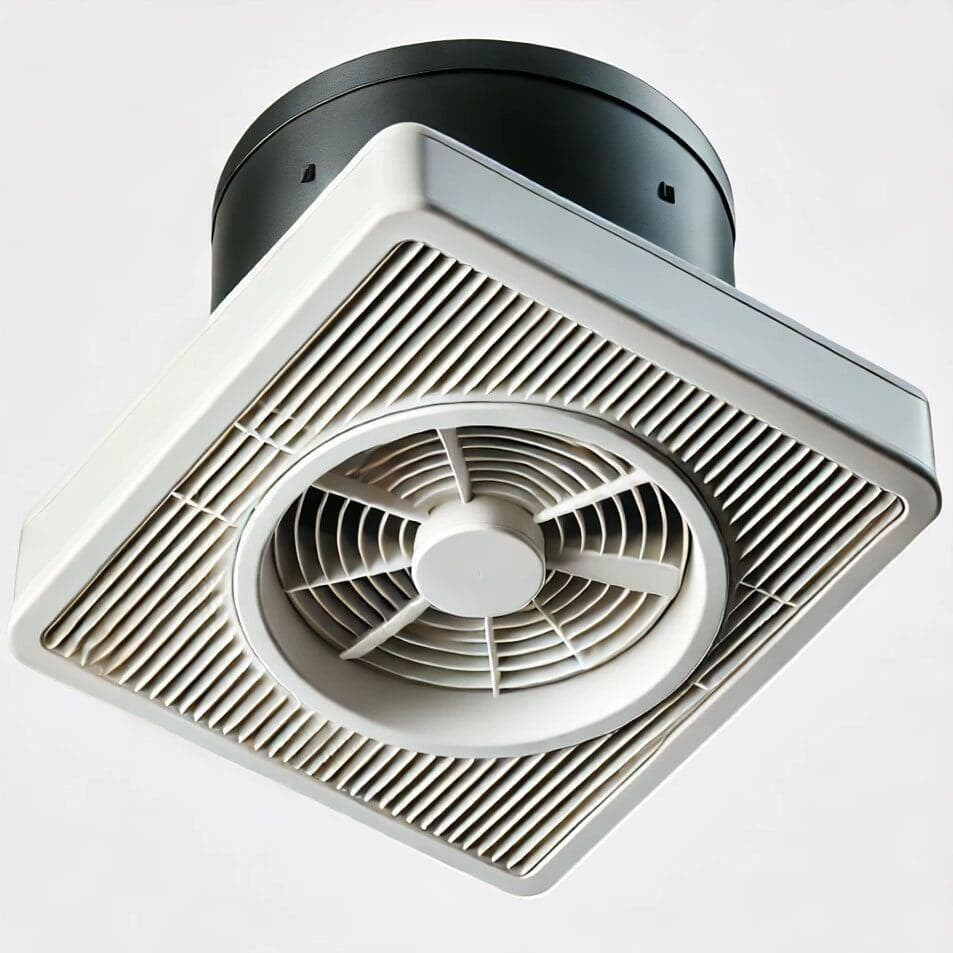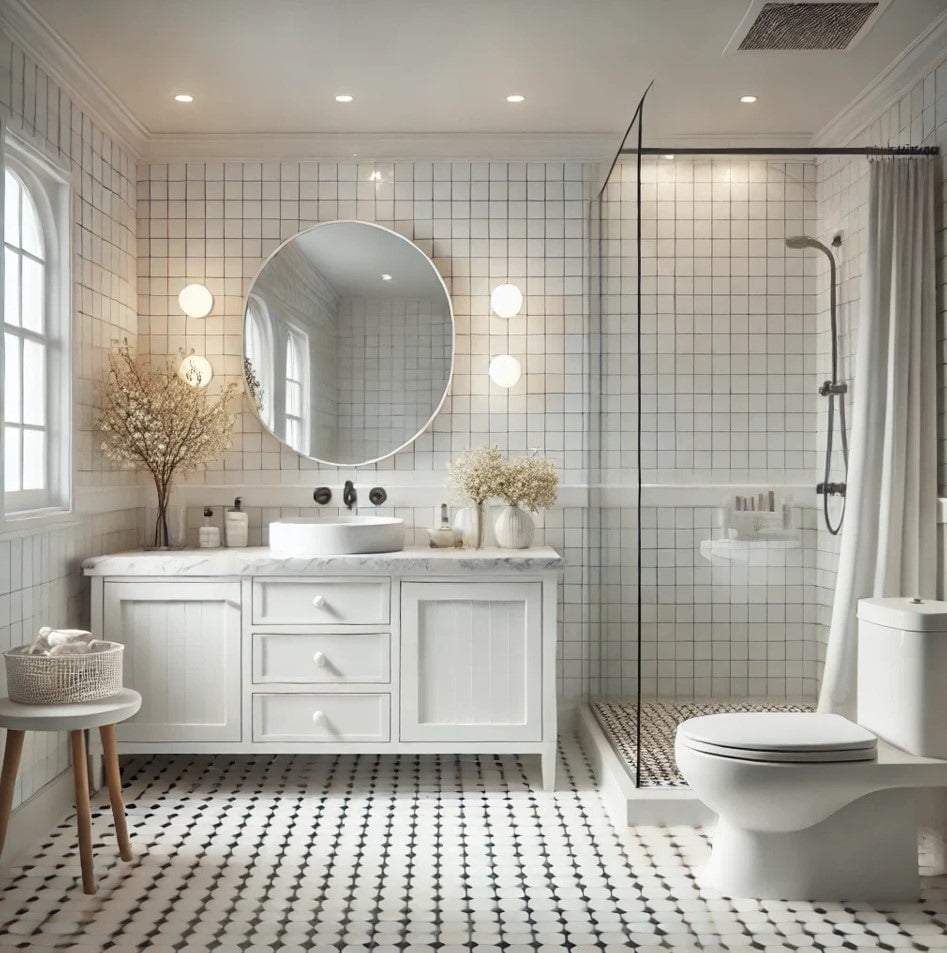
In any home, a well-functioning bathroom exhaust fan is essential for maintaining a healthy, moisture-free environment. This guide explores the various types of bathroom exhaust fans, their key features, and practical tips on selecting the best one to meet your specific needs. Whether you are renovating your bathroom or simply looking to improve its air quality, understanding these options will help you make the best decision.
Importance of Bathroom Exhaust Fans
Importance of Bathroom Exhaust Fans
An exhaust fan is essential for maintaining a clean and healthy bathroom environment. Without proper ventilation, moisture from hot showers can lead to mold growth, unpleasant odors, and damage to bathroom fixtures. Exhaust fans help to remove excess humidity, ensuring a dry and comfortable space.
Exhaust fans play an important role in regulating humidity levels in your bathroom. By removing moist air, they prevent condensation on walls and mirrors, reducing the risk of mold and mildew. This ventilation also improves indoor air quality and protects your bathroom's structural integrity.
Benefits
Benefits
- Prevents Mold and Mildew: Excess moisture is a breeding ground for mold and mildew, which can cause health problems and damage surfaces.
- Improves Air Quality: Ventilation removes pollutants and odors, making the bathroom environment more pleasant.
- Protects Fixtures and Finishes: Reducing moisture levels helps to preserve the condition of paint, wallpaper, and other bathroom finishes.
- Enhances Comfort: A well-ventilated bathroom feels fresher and more comfortable, especially after hot showers.
Common Issues Without an Exhaust Fan
Common Issues Without an Exhaust Fan
- Persistent dampness
- Mold and mildew growth
- Unpleasant odors
- Peeling paint and wallpaper
- Corrosion of fixtures
Types of Exhaust Fans
Types of Exhaust Fans
Selecting the right type of exhaust fan depends on your bathroom's layout and your specific needs. Here, we explore the three main types: ceiling-mounted, inline, and wall-mounted exhaust fans.
1. Ceiling-Mounted Exhaust Fan
1. Ceiling-Mounted Exhaust Fan

Ceiling-mounted exhaust fans are installed directly in the ceiling and are ideal for most bathrooms. They efficiently remove moist air and are available in various sizes and capacities.
Installation Process
Installation Process
Installing a ceiling-mounted exhaust fan involves cutting an opening in the ceiling, attaching the fan unit, and connecting the ductwork to an exterior vent. Electrical wiring is also required to power the fan.
How it works
How it works
A ceiling-mounted exhaust fan works by drawing air directly from the bathroom through a grill in the ceiling, with the fan motor and blades located within the ceiling unit, expelling air outside via ductwork.
Advantages
Advantages
- Effective for most bathrooms
- Wide range of models available
- Can include additional features like lights and heaters
Disadvantages
Disadvantages
- May require professional installation
- Can be noisy if not properly insulated
2. Inline Exhaust Fan
2. Inline Exhaust Fan
Inline exhaust fans are installed within the ductwork, usually in the attic or between ceiling joists. They are less visible and can be more powerful than ceiling-mounted fans.
Installation Process
Installation Process
Installing an inline exhaust fan involves cutting a hole in the ceiling to connect the ductwork, then installing the fan within the ducts. Electrical wiring is required both for power and control of the fan.
How it works
How it works
Inline fans draw air from the bathroom through ductwork to an exterior vent. They can serve multiple vents, making them suitable for larger bathrooms or multiple rooms.
Advantages
Advantages
- Quieter operation
- Can serve multiple vents
- Flexible installation options
Disadvantages
Disadvantages
- More complex installation
- Higher initial cost
03. Wall-Mounted Exhaust Fan
03. Wall-Mounted Exhaust Fan
Wall-mounted exhaust fans are installed directly on an exterior wall, providing a direct route for moisture-laden air to exit the building.
Best Scenarios for Use
Best Scenarios for Use
Wall-mounted fans are ideal for bathrooms without access to the ceiling or attic spaces, such as in older homes or basement bathrooms.
Installation Process
Installation Process
Installing a wall-mounted exhaust fan involves creating a vent in the exterior wall, connecting ductwork for proper airflow, and adding electrical wiring for effective power.
How it works
How it works
Wall mounted exhaust fan uses a vertical duct to expel air outside through the wall. They can be operated by a switch or timer, and some models come with built-in heaters for added comfort.
Advantages
Advantages
- Easy installation process
- Suitable for spaces without ceiling access
Disadvantages
Disadvantages
- Limited placement options due to exterior wall location
- More visible than other fan types
Essential Features of Exhaust Fans
Essential Features of Exhaust Fans
When selecting an exhaust fan, consider features that enhance functionality and convenience. Key features include humidity sensing, motion sensing, integrated lights, integrated heaters, and quiet operation.
Humidity Sensing
Humidity Sensing
Humidity-sensing exhaust fans turn on automatically when humidity levels get too high, helping to keep your space dry and comfortable. They're great for preventing mold and improving air quality in kitchens and bathrooms.
Motion Sensing
Motion Sensing
Motion-sensing fans activate when they detect movement, ensuring the bathroom is ventilated whenever it is in use.
Integrated Light
Integrated Light
Fans with integrated lights serve two key purposes in the bathroom: ventilation and illumination. These innovative units effectively circulate air to lower humidity and prevent mold, while also providing bright, energy-efficient lighting for better visibility.
Integrated Heater
Integrated Heater
Exhaust fans with integrated heaters provide warmth, making the bathroom comfortable during colder months. They also help to reduce moisture build-up, improving air quality and preventing mold.
Quiet Operation
Quiet Operation
Quiet operation is an important feature for ensuring a relaxing bathroom environment. The noise level of exhaust fans is measured in sones, with lower ratings indicating quieter performance. Look for fans with a sone rating of 2 or less for quiet operation.
Factors to Consider When Choosing an Exhaust Fan for Your Bathroom
Factors to Consider When Choosing an Exhaust Fan for Your Bathroom
Selecting the ideal exhaust fan involves considering various factors such as bathroom size, layout, and specific needs. Here’s a guide to help you make the best choice.
- Bathroom Size
- Bathroom Size
- Bathroom Size
Measure the square footage to determine the required CFM (cubic feet per minute) rating.
How do you calculate CFM for exhaust fan?
The most important part of choosing a bathroom exhaust fan is determining the right size for your bathroom. A fan’s ability to move air is measured in cubic feet per minute (CFM). The bigger the bathroom, the higher the CFM rating you’ll need. A fan should have a CFM rating high enough to replace the air in your bathroom at a rate of eight times per hour.
Steps to Calculate CFM:
- Measure Bathroom Dimensions:
- Measure the length, width, and height of your bathroom in feet.
- Calculate the bathroom size: Length × Width × Height.
- Convert Bathroom Size to CFM:
- Use the formula: Bathroom Size × 0.13 = Minimum CFM Rating
- For example, if your bathroom is 10 feet long, 8 feet wide, and 8 feet high:
Bathroom Size=10 ft × 8 ft × 8 ft = 640 cubic feet - Minimum CFM Rating= 640 × 0.13= 83.2 CFM
Vent Fan Size Recommendations
Choose a fan that can ventilate at least 1 CFM per square foot of room. For example, for an 80 square foot bathroom, select an 80 CFM fan. If you prefer to skip the math, check the fan’s packaging for the maximum square footage it can ventilate. Choose a fan based on your bathroom’s approximate square footage.
| Bathroom Size (sq. ft.) | Minimum Vent Fan Size (CFM) |
| Up to 50 | 50 |
| 50–100 | 50–80 |
| 100–150 | 100–150 |
| 150–200 | 100–130 |
| 200–300 | 130–170 |
| 300–400 | 170–210 |
2. Noise Level
2. Noise Level
Another crucial factor to consider is the noise level of the exhaust fan, which is measured in sones. A lower sone rating means a quieter fan. For instance, a fan rated at 1.0 sone or less is very quiet, while a fan rated at 4.0 sones or more will be noticeably louder. If you value peace and quiet, especially during early morning or late-night use, opt for a fan with a lower sone rating.
3. Energy Efficiency
3. Energy Efficiency
Fans with integrated lights serve two key purposes in the bathroom: ventilation and illumination. These innovative units effectively circulate air to lower humidity and prevent mold, while also providing bright, energy-efficient lighting for better visibility.
3. Humidity and Moisture Control
3. Humidity and Moisture Control
Exhaust fans with integrated heaters provide warmth, making the bathroom comfortable during colder months. They also help to reduce moisture build-up, improving air quality and preventing mold.
4. Installation and Venting
4. Installation and Venting
Quiet operation is an important feature for ensuring a relaxing bathroom environment. The noise level of exhaust fans is measured in sones, with lower ratings indicating quieter performance. Look for fans with a sone rating of 2 or less for quiet operation.
Choosing the right bathroom exhaust fan is important for keeping your bathroom healthy and comfortable. By understanding the different types of exhaust fans, their key features, and the factors to consider when selecting one, you can find the best option to suit your needs. Whether you prioritize quiet operation, energy efficiency, or advanced features like humidity sensing and integrated lighting, there's an exhaust fan that can improve your bathroom experience.
If you need help choosing and installing the right exhaust fan for your bathroom, feel free to contact us for expert advice and professional installation services.

